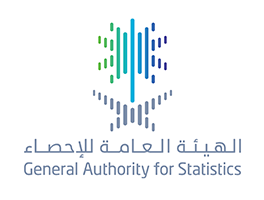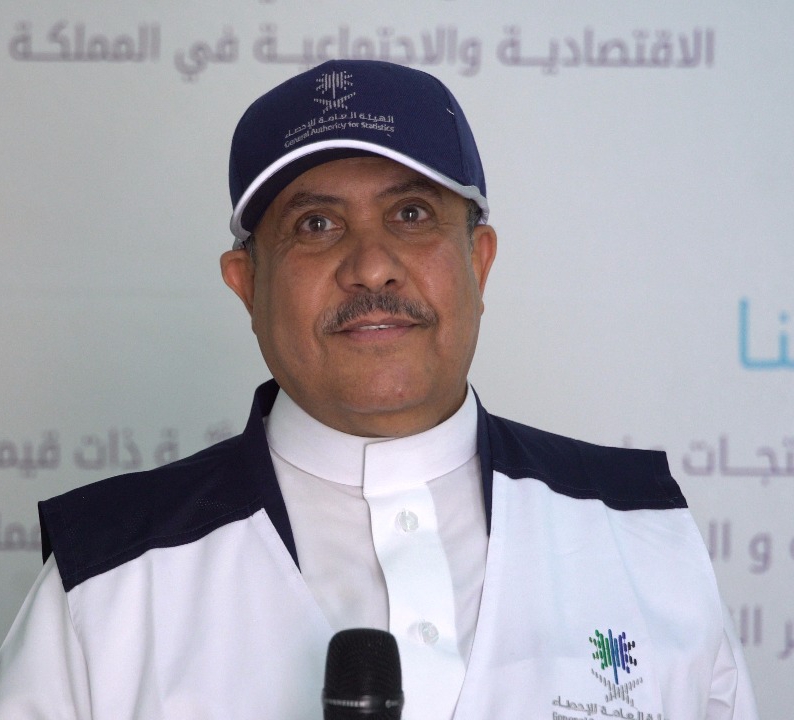
الهيئة العامة للإحصاء: ارتفاع الناتج المحلي بالأسعار الجارية 17.76٪
Based on the second-quarter National Account Indicators Report 2018
GASTAT: GDP rose by 17.76% at current prices
On Sunday 20 Muhrim 1440H / 30 September 2018, GASTAT released National Accounts Indicators Report for the 2nd quarter of 2018 on its official website www.stats.gov.sa The report showed an increase of 17.76% in Saudi Arabia’s GDP at current prices during the 2nd quarter of 2018 compared with the same period last year. The contribution of oil sector to GDP soared to 44.02% at current prices and 1.33% at constant prices compared with the same period in 2017.
Government sector’s contribution to GDP at current prices hit 18.01% and 4.01% at constant prices compared with the second quarter of 2017.
During the second quarter of 2018, private sector recorded an increase of 3.95% at current prices and 1.79% at constant prices, report added.
National Accounts Indicators Bulletin is issued by GASTAT on a quarterly basis and includes tables of GDP by economic activities and regulatory sectors at current and constant prices as well as the contribution of the regulatory sectors and the economic activities, government consumption expenditure, private consumption expenditure, capital formation, exports and imports.

الإحصاء والتنمية .. رعاية واهتمام من عهد المؤسس وحتى زمن الرؤية

وزارة الصحة، والهيئة العامة للإحصاء، والمجلس الصحي السعودي في تشاركية حكومية لتوفير قواعد بيانات صحيَّة لدعم التنمية
To prepare 189 health indicators and to establish a national monitor for health indicators
Collaboration between Ministry of Health, GASTAT, and Saudi Health Council to Provide Health Database for Development Support
With the aim of improving health indicators, Ministry of Health, GASTAT, and Saudi Health Council are working together to provide 189 health indicators through field and register-based statistical works, supporting the establishment of the national monitor for health indicators, preparing and publishing statistical health reports, meeting international, regional and local requirements of health indicators specially those related to World Health Organization (WHO) or to the Sustainable Development Indicators. More importantly, providing a health database that can be used by policy and decision makers and can also support researchers and those who are interested in the social field in general and in health in particular.
In addition, official spokesman of GASTAT, Tayseer AL-Moferraj, clarified that the integrated work between the three entities comes from the joint responsibility for health data and information in Saudi Arabia. On the other hand, GASTAT is the official statistical entity and regulator responsible for statistical works at the national level. Also, it is responsible for collecting data and information from the administrative records available at public entities and private establishments. Not to mention its responsibility in classifying and analyzing data as well as extracting its indicators. Moreover, GASTAT found a complete and a comprehensive combination of national statistical database of various fields in addition to centralized information system that is automatically linked with all public entities. On the other hand, Ministry of Health is the responsible entity for providing, assessing and evaluating health care services in Saudi Arabia. It also collects vital and health data about health activities, prepares related reports and makes, conducts and analyzes studies and scientific researches. At the same time, Saudi Health Council is in charge with studying and evaluating the level of health services. It is also concerned with establishing the national monitor for health, identifying the requirements of health sector, taking the necessary recommendations about distributing all types of health services in Saudi Arabia as well as improving the quality of health services.
AL-Moferraj added that the joint work which started with a number of meetings for the technical teams from the three entities has included cooperation, coordination, and provision of statistical and technical support to improve the national monitor for health, exchange data and health indicators that serve the production of national statistics and statistical database by linking the related entities through the Global Safety Network (GSN). Additionally, the joint work will also support the requirements of statistical field works as well as provide and improve data and statistical indicators given by the related entities and set for the statistical data program “Masdar”.
On the other hand, Tayseer AL-Moferraj clarified that the 189 health indicators that are going to be prepared and produced will contain new indicators as well, all of which are within Saudi Arabia’s commitment to publish health indicators related to the Sustainable Development Goals (SDG), such as: adults between (15-60 years old) mortality rate, under-five children mortality rate, infants mortality rate, newborn mortality rate, tuberculosis mortality rate, total fertility rate, new cases of vaccine-targeted diseases, cancer incidence rate, rate of exclusive breastfeeding for 6 months, prevalence of anemia among children, pollution level in cities, prevalence of hypertension among adults (18 years and above), diabetes among adults (18 years and above), salt intake for adults (18 years and above), lack of physical activity among adults (18 years and above) ( including teenagers), request for health care due to pneumonia, the coverage rate for each vaccine included in the nationally approved immunization schedule, easy access to health service (which means the percentage of individuals who live 5 Km away from a health facility), total expenditure on health (as a percent) of GDP, and other indicators that can be utilized for health planning.
It is worth mentioning that GASTAT has released the report of Household Health Survey 2017 results last July. It includs more than 85 indicators of health and social phenomena as well as household health in Saudi Arabia; in cooperation with the Ministry of Health. The above-mentioned report which was published on GASTAT website contains a number of indicators related to the health status in Saudi Arabia in addition to childhood and motherhood indicators and other indicators about the community’s healthy lifestyle. The report also includes data about smoking phenomena, accidents injuries, studies related to marriage, family planning, fertility and children mortality.

السعودية وكوريا الجنوبية توقعان اتفاقية للعمل المشترك في مجال تطوير العمل الإحصائي في البلدين
in order to transfer international practices and benefit from statistical experiences
Saudi Arabia and South Korea sign a joint work agreement to develop statistical work in both countries
On Thursday Muharram 3, 1440-H, corresponding to September 13, 2018, in the Saudi capital Riyadh, the General Authority for Statistics (GASTAT) in Saudi Arabia and Korea's statistics in the Republic of South Korea signed a joint work agreement related to the development of statistical aspects in order to activate the memorandum of understanding between the two countries for cooperation in the field of statistics that took place in the Korean capital “Seoul” last year and adopted by the Council of Ministers on 25/08 / 1439H corresponding to 10/5/2018. Additionally, the agreement was signed by the President of GASTAT Dr. Fahad S. Altekhaifi from the Saudi side , and by the official commissioner deputy of the Korean statistics , Mr.Sungwook Choi from the Korean side.
GASTAT official spokesman, Mr. Taiseer Almofarrej, explained that under these agreements, the Authority will benefit from best international practices in developing technical mechanisms necessary to collect and publish statistics according to international standards, identify statistical databases basics in various fields of statistics and exchange of experiences related to the requirements necessary to establish a central information system that is automatically linked with all public entities. It is noteworthy that this is what GASTAT is currently working on, through the National Statistical Data Program “Masdar” which operates according to three main dimensions: First, a statistical dimension that addresses the numerous sources of data and statistical indicators and their inconsistencies, their multiple classifications, as well as their collection in a traditional way. Second, availability and dissemination dimension that addresses the limited access to information in their time series and overcome some of the difficulties faced by data users and researchers to reach them. Third, the technical dimension, as “Masdar” is considered a safe and comprehensive technical solution that addresses the enormity of statistical data and the absence of central data repositories, to serve as a national statistical data bank and provide a variety of analytical tools that meet the needs of all analysts, researchers or decision makers.
Almofarrej also added that the agreement with the South Korean side included defining joint work mechanisms in exchange of experiences and benefiting from experts in the fields of establishing statistical departments in governmental entities as well as in the fields of statistical awareness programs, which will have a positive impact on the Authority, as it is currently working with a number of governmental entities in the Kingdom with a goal to activate the statistical sector. Furthermore, he pointed out that the Korean experience in the statistical field is considered one of the most distinct experiences internationally, and is the Saudi experience which characterized by the achievement of "statistical transformation. The South Korean delegation, during their visit to GASTAT, reviewed the work mechanisms that were carried out by the Authority during the last three years in the program of statistical transformation that was featured by integration with other governmental entities to maximize the use of data in supporting of decision-making and policy-making. Moreover, The Korean delegation reviewed work mechanisms in raising data quality level that operated by the Authority through an administrative and technical system in order to reach the highest level of data quality.
On the other hand, the head of the Korean delegation expressed his deep gratitude to the Saudi side for the hospitality and generosity after concluding the visit of the Korean delegation, which lasted two days with a number of meetings and workshops. He also stressed the deep relations between the two countries, which span more than half a century as well as how Saudi and South Korea's relations have significantly developed in all fields especially in the economic field.

رئيس الهيئة العامة للإحصاء يهنئ القيادة على نجاح موسم حج هذا العام
Expressing His Gratitude to All Private and Governmental Entities Which Contributed in Showing the Efforts of the Kingdom in Serving the Pilgrims
The President of GaStat Congratulates the Leadership on the Success of the Hajj Season for This Year
On behalf of GaStat employees and on his own behalf, Dr.Fahad Bin Sulaiman AL-Tukhaifi congratulates The Custodian of the Two Holy Mosques King Salman Bin Abdulaziz AL-Saud, and HRH Prince Mohammed Bin Salman Al-Saud Deputy Crown Prince, Second Deputy Prime Minister and Minister of Defense of Saudi Arabia, May Allah protect them, on the success of the hajj season for the current year 1439 H. Assuring that the directions of the King and the Crown Prince to provide all amenities for the pilgrims were the fundamental for the GaStat and all private and governmental entities to implement their programs to serve the pilgrims. Moreover, he has indicated that the concern of the leadership, May Allah protect them, was the reason behind the all successes that have been achieved during the hajj season of this year, where all sectors have worked closely to achieve the expectations of the leadership in reality.
Moreover, the president of GaStat, has extended his congratulations to HRH Prince Khalid ALFaisal Bin Abdulaziz , the Advisor to the Custodian of the Two Holy Mosques, Governor of Makkah Province and the Chairman of the Central Hajj Committee, for his effective role in following-up the implementations of the Hajj’s plans up to date and for his concern to ensure comfort for pilgrims by providing all the means that could help them to perform the rituals easily.
In addition, Dr. AL-Tukhaifi congratulates HRH Prince Abdulaziz Bin Saud Bin Naif Bin Abdulaziz, the Minister of Interior and the Chairman of the High Hajj Committee, on the success of the 1439 hajj season as well as his own implementation plans, with Allah’s help. Moreover, He has praised the great role that has been played by the employees of the Ministry of Interior from all security sectors for the success of the hajj for this year. As usual, they were distinguished with their dedication in showing the honor of serving the pilgrims. Dr.AL-Tukhifi also wishes all the best and success for them and for everyone.
Additionally, the president of GaStat has announced the success of the hajj statistical plan for this year, with Allah’s help, and with the early preparation and teamwork spirit of GaStat employees , where they have worked closely with all governmental and security entities to implement the hajj statistical program. They were also able to provide a comprehensive and accurate statistical outputs to support all decision makers and hajj development policies makers through the detailed statistical bulletin for hajj statistics, which includes 40 statistical outputs. Also, by publishing the statistics of the efforts of Saudi Arabia in serving pilgrims through “the statistical calendar for 1439H hajj season” which has been published for the second year respectively through GaStat. The president of GaStat has expressed his gratitude to all governmental entities which provided their data to GaStat, in advance, to be used to show the efforts of the Kingdom by numbers and a scientific and accurate statistical method.
It is worth mentioning that the GASTAT has announced on the evening of the day of 'Arafa the results of hajj statistics for the current year 1439H, where the total number of pilgrims reached (2.371.675) pilgrims, including (1,758.722) pilgrims coming from outside the Kingdom, while the number of pilgrims coming from inside the Kingdom made up of (612.953) pilgrims.

" الإحصاء ": الإعلان النهائي عن إجمالي أعداد حجاج 1439هـ بعد مغيب شمس يوم عرفة
The Detailed Bulletin for Hajj Statistics Will Be Issued on Eid day with (40) Statistical Outputs
GASTAT: The Final Announcement of Pilgrims’ Total Number in 1439 H is after the Sunset of the Day of Arafah
As it continues publishing up-to-date statistics every six hours, GASTAT announced that the enumeration of pilgrims for the hajj season of this year 1439 H, which is through the ports of Makkah, will stop at 6:30 along with the sunset of (the day of Arafah) on Monday, the ninth of Dhu AL-Hijjah. Moreover, the time of the final announcement of the total number of pilgrims will be few hours later on the same day. However, the time of publishing the detailed bulletin of Hajj statistics 1439H will be on Tuesday (Eid day) at 11 A.M.
The vice president of the statistical works Mr.Abdullah AL-Batil assured that the hajj statistical bulletin which will be published on Eid day includes (40) main statistical outputs to support the planning of serving pilgrims and the visitors of the Two Holy Mosques. AL-Batil illustrated that the bulletin includes accurate and comprehensive data and information about the numbers of pilgrims according to the ways and dates of arrival. It also includes a number of main tables and charts such as: the number of pilgrims from inside Saudi Arabia by gender and way of arrival, the arrival of Saudi pilgrims by way of arrival, Non-Saudi pilgrims from inside Saudi Arabia classified according to gender and nationality, the Non-Saudi pilgrims from inside classified by way of arrival, comparing the number of Non-Saudi pilgrims from inside according to their nationalities, the number of vehicles carrying pilgrims from inside to the city of Makkah according to the vehicle type and the date of arrival, pilgrims from outside Saudi Arabia distributed according to gender and way of arrival, pilgrims from outside Saudi Arabia distributed according to gender and the date of arrival, comparing the number of pilgrims from outside according to the way of arrival. These data will be available with more than one template including the statistical hajj map which facilitates the access to any information that is related to hajj statistics.
On the other hand, the vice president of statistical works assured that the program of hajj statistics which is implemented by GASTAT aims to provide accurate and detailed statistics, data, and information about the number of pilgrims from inside and outside Saudi Arabia to help and support the concerned entities of Saudi Arabia in the future planning programs for the purpose of ensuring the necessary services for pilgrims and visitors of the holy mosque, including all social, health, security, food, and transportation services. That is through using time series of accurate data about the numbers of pilgrims, estimating the necessary labor force to serve the pilgrims and maintain their safety and comfort during the hajj season every year, examining the equipment and the main utilities in the city of Makkah and its Holy places with taking that into consideration when preparing the necessary plans, applying the necessary annual traffic plans including the plan of the mass movement of pilgrims (Tasaeed and Nafrah), in addition to supporting the researchers and other beneficiaries who are interested in this field, evaluating the activities and the events arranged by the concerned entities of serving pilgrims, and identifying the change in the way of arrival.
About the inclusiveness of the enumeration process and whether it includes buses and vehicles drivers, Mr.Abdullah AL-Batil clarified that the enumeration unit of Hajj statistics is the pilgrim. Which means that the procedure of the enumeration of pilgrims from inside Saudi Arabia is restricted to pilgrims who were enumerated at the Hajj statistical centers that are located in the entry ports of the city of Makkah, the driver will be enumerated in case he was a pilgrim. The enumeration procedure includes all Saudi and Non-Saudi individuals (males and females) arriving from inside Saudi Arabia to the city of Makkah with Hajj intention. However, pilgrims from outside Saudi Arabia will be enumerated by the General Department of Passports at the entry ports of Saudi Arabia. GASTAT will be provided with their numbers to be added to the total number of pilgrims from inside Saudi Arabia.

الهيئة العامة للإحصاء تعمل بمنظومة تقنية متقدمة في تنفيذ "إحصاءات الحج"
Hajj statistics updates every (6 hours) via an interactive map on the site
GaStat operates an advanced technical system in the implementation of "Hajj statistics"
The General Authority for Statistics (GaStat) is currently implementing a comprehensive technical system, with more than 470 statistical researchers working in six main entrances to Makkah and three support centers in Medinah, Jeddah and Al Tai’f. The system is connected to a secure electronic network for simultaneous and immediate data flow to the main centers. Moreover, the GaStat updates the interactive statistical map of Hajj every six hours through its official website www.stats.gov.sa
Mr. Khalid Al-Dalqan, Information Technology Under Secretary at GaStat, said that GaStat is working continuously to develop the methodologies and programs needed to collect, process, analyze and disseminate data to achieve comprehensiveness, reliability and timeliness in data dissemination through the use of modern technology that contributes to reducing the time and place factors which may delay data processing speed and accuracy as well as the speed of extraction and data dissemination during Hajj. GaStat has applied a modern method of collecting field data using the latest technology and software by using electronic forms on tablets when counting pilgrims, which allow quick access to daily data and total results of the number of pilgrims classified according to their nationalities, centers and times of arrival. He added that all statistical researchers in Mekkah have been trained to use modern technology and devices effectively to implement the Hajj statistics program using tablets connected with the main servers in Riyadh in addition to the link to backup servers in all statistical centers that work offline if needed.
Moreover, Al-Dalqan said that the Authority has allocated a technical support team working around the clock ( in order to train all employees categories to use Hajj systems, know how to extract daily reports, follow up the productivity of field work groups and solve all technical problems that may face the work groups during data collection), Furthermore, it has dedicated other work teams for the preparation distributed to all main and support statistical centers. GaStat provided analysis and design teams as well as a team to develop data collection systems, including the tablet system used to collect field data that includes a digital form to count pilgrims containing all data on the results of pilgrims enumeration numbers arriving in Makkah connected to the coordinates of the information gathering site. These devices work via a remote control systems that allow the tracking devices to provide remote technical support.
On the other hand, Information Technology Under Secretary at the GaStat pointed out that the Hajj statistics platform of the technical system was added to Hajj of this year for the main center and the main counting centers. This allows the specialists to review the pilgrims statistics of this year updated in comparison to the historical data at the level of arrival centers of pilgrims coming from inside the Kingdom, their nationalities, arrival time and types of vehicles, in addition to the statistics of pilgrims coming from outside the Kingdom as well as the pilgrims of Mekkah.
It is worth mentioning that GaStat has standardized the definitions and terminology used in Hajj statistics, where the pilgrim is the counting unit. The process of counting pilgrims coming from inside the Kingdom is limited to the persons wearing Ihram who are already been counted at the centers of Hajj statistics at the entrances to Makkah. The counting includes All Saudi and non-Saudi individuals, males and females, coming from different regions of the Kingdom to Makkah for the purpose of performing Hajj, with the addition of the total number of pilgrims coming from outside the Kingdom counted by the General Directorate of Passports at the points of entry in the Kingdom of Saudi Arabia.

الهيئة العامة للإحصاء تُطلق "خريطة الحج الإحصائية" لنشر البيانات وتسهيل الحصول على المعلومة
To know the statistics details of pilgrims arriving to Makkah every (6) hours
GASTAT launches the “Hajj statistical map” to publish data and facilitate information access
The General Authority for Statistics (GASTAT) launched the “ Hajj statistical map” on its official website www.stats.gov.sa . This map is considered one of the most important references that clarifies the details of pilgrims’ statistics data, and facilitates information access to media, researchers, and governmental entities, so that they can use them in details and with the most advanced methods of “geo-spatial” data publishing. The map can be viewed via different multimedia.
Taiseer Almofarrej, GASTAT spokesman, said that the process of letting people view Hajj statistics data complements GASTAT efforts in publishing statistical data. Everyone can view the numbers of pilgrims arriving to Makkah through all ports in an updated way (every six hours), starting from Saturday the 7th of Dhu-Al-Hijjah until the end of pilgrims’ enumeration on Monday the 9th of Dhu-Al-Hijjah at 7 P.M. This map will be an interactive statistical reference for Hajj statistics.
Almofarrej indicated that the Hajj statistical map has two tracks; the first is the news track through which hajj statistics can be accessed in an updated way (every six hours) via the map. The numbers of pilgrims coming from outside Saudi Arabia, and the numbers of pilgrims coming from inside Saudi Arabia (Saudis and Non-Saudis) can be accessed too. Moreover, this track includes the number of vehicles carrying pilgrims from inside Saudi Arabia by type of vehicle, the number of licenses given to pilgrims from inside Saudi Arabia, and the traffic map in the holy places area.
However, the second track, as stated by GASTAT spokesman, is a statistical reference track. Starting from Tuesday, the tenth of Dhu-Al-Hijjah, the interactive map will be one of the Hajj statistics’ detailed bulletin templates through which all governmental entities, researchers, media, and all those who are interested can get the numbers of pilgrims from inside and outside Saudi Arabia, the statistical distributions of pilgrims from inside Saudi Arabia at the level of enumeration centers, number of Saudi and Non-Saudi pilgrims from inside Saudi Arabia, number of Non-Saudi pilgrims from inside and outside Saudi Arabia by groups of countries, estimating the numbers of pilgrims in Makkah, number of labor forces serving pilgrims by gender and sector, and the numbers and types of vehicles carrying pilgrims from inside Saudi Arabia during the period (from 1st to 9th of Dhu-Al-Hijjah). The interactive map will provide details of gender and nationality by entry, in addition to the time series of pilgrims during the past ten years.
It is worth mentioning that GASTAT is working on diversifying the methods of getting data in a detailed and immediate way through all available means. It has also launched the “statistical calendar of 1439 H Hajj season” in which it published the services provided by Saudi Arabia to pilgrims.
GASTAT: The total number of pilgrims in 1439H Hajj season reached (2.371.675) pilgrims
GASTAT: The total number of pilgrims in 1439H Hajj season reached (2.371.675) pilgrims
On Monday, the ninth of Dhu-Al-Hijjah, the General Authority for Statistics announced the results of 1439H Hajj statistics. The total number of pilgrims reached (2.371.675) pilgrims, (1.758.722) of whom came from outside Saudi Arabia, whereas (612.953) came from inside Saudi Arabia. However, the total number of male pilgrims reached (1.327.127) pilgrims, while female pilgrims reached (1.044.548) pilgrims.
With respect to the pilgrims arriving from outside Saudi Arabia, GCC pilgrims reached (34.140) pilgrims with (1.9) %, but the number of pilgrims from Arab countries apart from GCC pilgrims reached (395.410) pilgrims with (22.5) %, whereas the number of pilgrims from Asian countries apart from Arab countries reached (1.049.496) pilgrims with (59.7) %. In addition, the number of pilgrims from African countries apart from Arab countries reached (166.083) pilgrims with (9.5) %. However, the number of pilgrims from European countries reached (88.601) pilgrims with (5.0) %, whereas the number of pilgrims from North America, South America, and Australia reached (24.992) pilgrims with (1.4) %.
Moreover, (1.656.936) pilgrims who came from outside Saudi Arabia arrived through air ports, and (85.623) of whom arrived through land ports. However, (16.163) pilgrims arrived through sea ports.
Additionally, the pilgrims’ arrival to Saudi Arabia was at different periods of time. (557.282) of pilgrims coming from outside Saudi Arabia at the beginning of hajj until the 18th of Dhu AL-Qidah, and (744.903) of pilgrims arrived between 19-29 of Dhu AL-Qidah. Moreover, (456.537) of pilgrims continued to arrive to Saudi Arabia during the time period from 1 to 8 of Dhu AL-Hijjah.
Regarding the pilgrims who came from inside Saudi Arabia whose numbers reached (612.953) pilgrims this year, the total number of pilgrims arriving from the cities and governorates of Saudi Arabia reached (239.962), (372.991) of whom are from the city of Makkah including the temporary residents during the hajj season, (401.217) are Non-Saudi pilgrims, and (211.736) are Saudi pilgrims.
GASTAT has enumerated the pilgrims arriving to Makkah from inside Saudi Arabia (Saudis and Non-Saudis) through the hajj statistics centers located in the entrances of Makkah. In addition, the percentage of pilgrims arriving to Makkah from inside Saudi Arabia through Jeddah/Makkah road reached (38.2) %, (29.4) % arrived through AL-Shrae’a/Makkah road, and (17.8) % arrived through Makkah/Medina road. Moreover, (14.6) % arrived through the other three roads which are the South/Makkah road, Taif/Makkah road, and the old Jeddah/Makkah road.
GASTAT illustrated in its results of hajj statistics of this year that the seventh, eighth and ninth days of Dhu AL-Hijjah have witnessed an arrival reached (86.8) % out of the total number of pilgrims who came from inside Saudi Arabia. On the other hand, the number of vehicles carrying pilgrims from inside Saudi Arabia reached (32.289) vehicles.
As for the number of the labor force of entities that provided their services to pilgrims from all sectors, the numbers of governmental entities’ labor force reached more than 287.300 persons representing some governmental and private entities which participated in providing more than 215 main services and sub-services. Supervision and follow-up services were provided by 7310 male and female supervisors from 6 entities. However, public services were provided by 192.254 employees from 19 different entities, whereas health services were provided by 32.579 employees from 3 entities. Furthermore, the number of the labor force in transportation and post services, as well as logistic services (shipping, post and supply) that Saudi Arabia provides to pilgrims reached 47.765 employees working in seven entities, while ICT services were provided by 7.411 employees from 4 different entities.
On the other hand, his excellency the president of GASTAT, Dr.Fahad Altekhaifi thanked all the governmental security entities that supported GASTAT to implement its task in the hajj statistics of this year. He also praised the work of more than 450 statistical researchers who completed their assigned tasks for the hajj of this year after working 24/7 starting from the beginning of this month until the sunset of the day of Arafah.
Dr.Altekhaifi assured that all the details related to hajj statistics of the year 1439H have been published along with this announcement through the statistical hajj map and the detailed bulletin for hajj statistics which include more than (40) statistical outputs on GASTAT official website www.stats.gov.sa to provide accurate and detailed statistics, data and information about the number of pilgrims from inside and outside Saudi Arabia to help and support the concerned entities in their future planning programs for the purpose of ensuring the necessary services for pilgrims., including all social, health, security, food and transportation services by using time series of accurate data about the number of pilgrims, estimating the necessary labor force to serve the pilgrims and maintain their safety and comfort during the hajj season every year, examining the equipment and the main utilities in the city of Holy Makkah and its Holy places with taking that into consideration when preparing the necessary plans, in addition to supporting the researchers and beneficiaries who are interested in this field, evaluating the activities and the events arranged by the concerned entities of serving the pilgrims, and identifying the change in the way of arrival.
The statistical map and bulletin includes accurate and comprehensive data and information about the number of pilgrims according to the ways and dates of arrival. It also includes a number of main tables and charts such as: the number of pilgrims from inside Saudi Arabia according to gender and the way of arrival, the arrival of the Saudi pilgrims according to the way of arrival and nationality, comparing the number of the Non-Saudi pilgrims who came from inside Saudi Arabia in the years 1438H and 1439H by nationality, the number of vehicles carrying pilgrims who came from inside Saudi Arabia to the city of Makkah by vehicle type and the date of arrival, pilgrims from outside Saudi Arabia distributed according to gender and the way of arrival, pilgrims from outside Saudi Arabia distributed according to gender and the date of arrival, and comparing the numbers of pilgrims coming from outside in the years 1438H and 1439Haccording to the way of arrival.
By the end of the Hajj statistical works, GASTAT wishes that God accepts the pilgrims’ hajj and wishes success to all governmental and security entities and to other entities in Saudi Arabia to serve distinguished services and come out with a safe and distinct hajj season.
